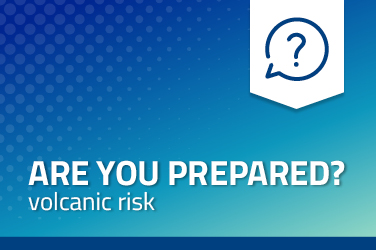Are you prepared? - Volcanic risk

Italy, together with Iceland, has the greatest concentration of active volcanoes in Europe and is one of the first in the world for the number of inhabitants exposed to volcanic risk. Active or potentially active volcanoes are situated in southern Italy with varying degrees of hazard.
Those who live or are in the volcanic zone must be informed about their local authority’s emergency plan, to be able to follow the Civil Protection authorities’ instructions on what to do in cases of eruptions and any eventual evacuation operations, if required.
Wrong information can be easily communicated during a crisis, with the risk of hampering the rescue work. For this reason it is important to follow the civil protection authorities’ instructions transmitted by radio, TV, in the daily press, on Internet and by the various toll-free numbers that will be set up.
During eruptions, it is also important not heed the forbidden to enter signs at the areas involved by the eruption. It is dangerous to approach the crater area even if there is no eruptive activity as sudden explosive phenomena o gas emissions are always possible.
Specific instructions on what to do can be found below.
Do not walk near an active lava flow even when it flows regularly. It is very hot and releases gases. Also, it can produce incandescent boulders and sudden explosions.
Even at the end of the eruption, do not walk on the surface of a lava flow. The flows retain their heat for years.
Find information about the location of your building and if it is subject to fallout of coarse materials. It is a phenomenon very destructive for the buildings that do not constitute a valid shelter in these cases.
Check the emergency plan of your municipality and prepare for a possible evacuation. The removal from the area is the only possible form of defense.
Volcanic ash fallout, even for prolonged periods, does not pose a serious health risk. However, prolonged exposure to the finest ash (less than 10 microns) may cause moderate respiratory distress. Also, eye contact may cause conjunctivitis and corneal abrasions. Therefore, it is advisable to take some precautions and assume appropriate behaviors to reduce exposure, especially for some categories of subjects: people suffering from chronic respiratory diseases (asthma, emphysema, etc..); people suffering from cardiovascular disorders; elderly people and children.
During the phases of the ash fall (or during windy days if the ash is already on the ground) it is advisable to stay indoors with the windows closed or go out taking care to wear a mask for protection from dust and possibly dust glasses. These self-protection devices are particularly suitable for the categories at risk and for those who carry out professional activities outdoors
In case of eye contact avoid rubbing the eyes, and wash them with plenty of water
Periodically remove the ashes from their environments, being careful to wet the surface beforehand, in order to avoid the lifting and re-suspension of the thinner parts. During these operations, wear the protective equipment.
Periodically remove the ashes accumulated on the roofs of the houses, with the help of appropriate safety equipment (scaffolding and harnesses), to avoid an excessive overload on the roofs and prevent possible collapses, as well as the clogging of the eaves channels
Do not spread the ashes along the roads, collect them in bags to deposit in the collecting points identified by the municipality. Ashes can clog water and sewer networks and constitute a danger to road traffic.
Drive with particular caution on stretches of road covered with ash
Avoid the use of motorcycles
Fruit and vegetables that may be covered with ash can be consumed after a careful washing
Pets (dogs, cats, etc.) shall stay indoors
Volcanic ash ingested by grazing animals can cause serious consequences on the digestive system. Therefore, in case of abundant ash fall, it is advisable to supply the livestock with ash-free fodder
Avoid stopping or camping in volcanic areas or entering underground environments. Carbon dioxide is an odorless gas heavier than air and lethal in high concentrations.
Don't think you are safe if you camp far from the crater area. There may be gas emissions in more distant areas as well.
Prepare for possible evacuation. The only defense against this type of flow is preventive removal from the area that could be affected by eruption.
Follow the civil protection plan showing waiting areas and move away from areas at risk. The ash can trigger dangerous mudflows that spill along waterways.